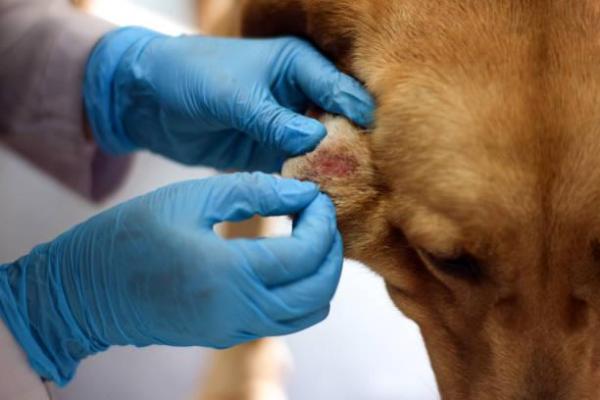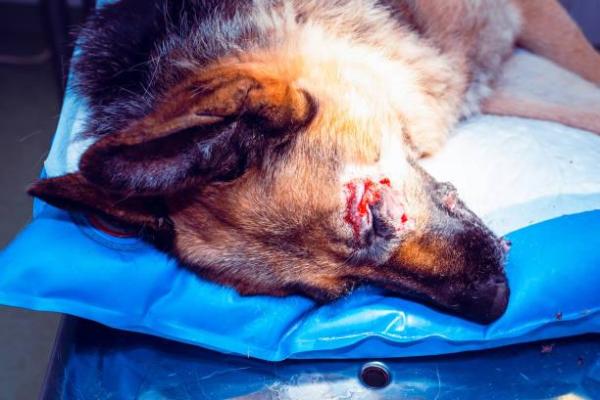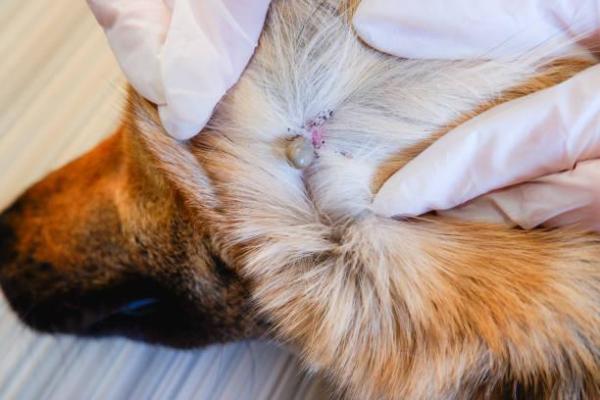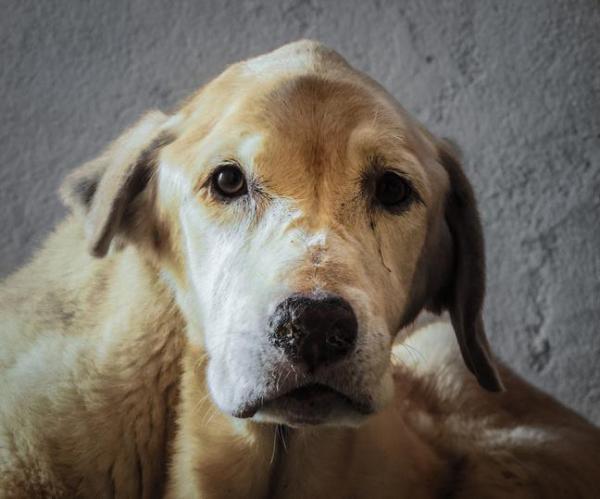Lump on My Dog's Head



See files for Dogs
Finding a lump anywhere on our dog's body will be cause for concern, but lumps on a dog's head mean they are on a particularly sensitive part of their anatomy. For example, the proximity to the brain makes metastasis of cancers even more dangerous than it already is. This doesn't mean lumps or bumps on dogs are necessarily dangerous, even if they do develop on their head. Important factors to determine their threat include their size, consistency and whether or not they are under the skin. Some may be soft bumps spread out over the skin, while other might be hard lumps under one place.
At AnimalWised, we help look at the possible causes of a lump on my dog's head. In addition, we discover what sort of treatments may be available. Regardless of the cause, a differential diagnosis by a veterinarian is required since they are not a symptom which can go ignored.
Hematoma
As we have stated in the introduction, the consistency of a lump on a dog will help to determine its cause. If your dog has a soft lump on their head, it is likely filled with fluid. This fluid could be lymph fluid, pus or blood, among others. If the fluid inside is blood, it is known as a hematoma.
Considered a type of bruise, a hematoma usually occurs due to trauma. If the dog has fallen, been hit with something or even been in a fight, a hematoma can develop. Since the dog leads with the head, it is common for traumatic injuries to occur here.
Treatment of a hematoma on a dog's head
When the blood causes a lump under the skin on a dog's head, it is possible it will go away on its own. With mild injuries, the hematoma will reduce in size as the blood is drained away. The dog will likely live their life as usual and it will not interfere in their general well-being, although we need to be careful not to touch the area as it will likely be sensitive and even painful.
If the traumatic injury is serious, then we need to take them to a veterinarian. A hematoma in dogs is itself benign, but the other damage which the injury caused may not be. Especially since the trauma occurs on the dog's head, we need to be careful the brain is not damaged. The veterinarian may run imaging tests for injuries such as an intercranial hematoma which can be fatal. However, it will not be visible without imagining tests.
Discover the specific causes and treatment of a hematoma on a dog's ear.
Abscess
Infections are a common cause of bumps on a dog's head, but they can vary greatly in severity. Fungal skin infections can cause small bumps to appear over a dog's skin, but serious bacterial infections can lead to complications such as abscesses. Abscesses occur when the immune response of the dog causes pus to accumulate under the skin, but it cannot escape. The result is a subcutaneous lump.
A common example of a lump due to abscess on a dog's head is getting into a fight. Since the dogs involved will try to strike at their sensitive areas, they can bite the skin and bacteria from their teeth enters the wound. It is also possible foreign objects become embedded in the skin and lead to secondary bacterial infections. Even a very bad ingrown hair can cause abscesses in dogs.
Treatment of abscess on a dog's head
It is important to note that abscesses can remain closed or open. In a location as delicate as the head, they can cause the dog considerable pain and discomfort. If your dog has a lump on their head which may be an abscess, take them to a veterinarian. Antibiotic drugs may be enough to reduce the purulence, but a vet may also wish to drain the abscess if there is danger to their well-being.

Sebaceous cyst
Sebaceous cysts are fatty lumps that can also appear on the head of a dog. They are usually firm to the touch and they can move around easily under the skin. Sebaceous cysts are caused by the accumulation of sebum secreted by the sebaceous glands in the skin. They are benign and do not pose any major threat to the dog's well-being, although they can rupture and cause bleeding.
Treatment of sebaceous cyst on a dog's head
Some sebaceous cysts may be of a size or in a location which can pose a threat to the dog's well-being, e.g. being too close to their eye. In these cases, it is possible the veterinarian will want to excise the lump. While heat treatment may be able to reduce some cysts, if they are sufficiently large, surgical excision will be used. This will be done with a small cut at the base of the cyst and the contents are removed.
Learn more with our article on the causes and treatment of sebaceous cysts in dogs.
Pimples
Pimples do not usually appear as one single lump. They are usually a serious of small bumps which can vary in size and consistency, depending on their cause and extent. They are often small and not always easy to see, especially in long-haired dog breeds. They can be due to hormonal imbalances, folliculitis, dermatitis or as an allergic reaction, among other possible causes.
Treatment of pimples in dogs
Ideally, the cause of the pimples should be identified. The symptoms can also be managed if we see that they are causing discomfort, such as itching, restlessness or pain. If the bumps are spreading or becoming infected, treatment will be required. The nature of this treatment will depend on their cause. For example, a hormonal imbalance may required medication to redress it.
Bite or sting
Especially during the warmer seasons of the year, it is not uncommon for a dog to be bitten or stung by another animal. Since dogs will often investigate insects and other creatures with their mouth, it is common for them to be stung or bitten on the head. This can be from a mosquito, tick, wasp, spider or even a large animal such as a porcupine, although this will be due to quills rather than venomous stingers.
While these bites and stings will usually not be life threatening and will go away on their own, it is possible they can become infected. In these cases, lumps or bumps on the head can appear. It is especially important to monitor these if they appear on the dog's head.
Treatment of bites or stings in dogs
In principle, we can treat them by washing with soap and water and applying cold compresses if there are no complications. Of the dog shows any symptoms such as head swelling or even respiratory problems, we should go to the veterinarian immediately. This is especially important if there is an allergy to the bite or sting, since the dog can have go into anaphylactic shock. The veterinarian can apply antihistamines to stabilize the animal, as well as antibiotics to treat infections.
Learn what to do if a dog is stung by a wasp with our related guide.

Tumors
Finally, if your dog has a lump on their head, it is vital we consider the possibility of a tumor. Neoplasms are growths which are caused by the disorganized, abnormal and excessive proliferation of cells. Their causes are difficult to determine, with many of them being idiopathic. While dogs can have benign tumors on their head, it is possible they are malignant, i.e. cancerous.
The type of tumor on the dog will be important in understanding its repercussions. For example, a lipoma in dogs is a type of benign fatty tumor which will not cause direct harm, but it can be dangerous if located on sensitive tissues on the head. If the tumor is malignant, it can metastasize and spread to neighboring tissues. When the tumor is on the head, this can spread to the brain and result in the death of the animal.
Since tumors are serious causes of lumps on a dog's head, they cannot be ignored. The veterinarian may need to take a biopsy or similar type of sample to determine the type of tumor. Blood tests, imaging tests and other diagnostic tests will be carried out the assess the danger.
Treatment of tumors on a dog's head
Taking into account all the information they can garner, the veterinarian will choose the most appropriate treatment and will explain the prognosis. For example, a benign lipoma can be easily removed if it is posing a threat to their well-being. A malignant sarcoma or similar tumor cannot be so easily removed and may require additional treatments such as radiotherapy or chemotherapy.
As we can see, there are many different causes of lumps and bumps on a dog's head. In many cases, these are benign, but the possibility of a serious health condition means we should always get them checked out by a veterinarian. In the case of a tumor, early detection can be the difference between a poor and a good prognosis.
Discover more about a type of lump on a dog's head with our article explaining the symptoms and treatment of a soft tissue sarcoma in dogs.

This article is purely informative. AnimalWised does not have the authority to prescribe any veterinary treatment or create a diagnosis. We invite you to take your pet to the veterinarian if they are suffering from any condition or pain.
If you want to read similar articles to Lump on My Dog's Head, we recommend you visit our Other health problems category.








